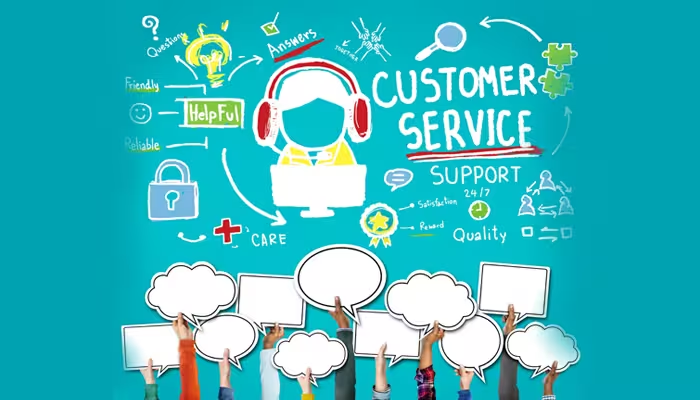
Introduction to Social Media for Customer Service
Do you remember the old times when the only point of contact with brands and companies was a phone number? Sometimes, you had to wait for hours to reach a customer representative, and when you had your chance, your issue was not resolved at all. You would have to hang up with frustration; without any follow-up options, you would bow to the inevitable. Fortunately, those times have passed, and nearly all businesses offer online customer service as well as support on social media channels now. Social media customer service has become the savour of consumers around the world. But it comes with challenges for brands.Social media for Customer Service
In this complete guide to social media for customer service, you will learn everything that your business needs to provide world-class customer support on social media for customer service.
Importance of Social Media for Customer Service:
It’s important to know how you can make your customer service improvise utilizing social media. This article gives you tips on social media usage to help improve the communication between customer service and customers.
Social media allows companies to reach out to potential customers in a very quick and easy manner. It also helps companies to maintain contact with past customers, and even bring them back so as to service them in the future. An effective social media strategy for customer service is vital in order to make your company grow, maintain existing customers, and attract new ones
Common Social Media Platforms for Customer Service:
Social media for Customer service is a valuable tool for engaging with your customers. Here are some of the most popular social media platforms that can enhance your customer service effort. Platform are given below
What Are the Benefits of Social Media for Customer Service:
- Enhanced Accessibility and Convenience
- Cost Reduction
- Strengthens Brand Equity
- Valuable Data and Insights
- Crisis Management
1 Enhanced Accessibility and Convenience
Customers can reach out to businesses at any time, from any location, and receive timely responses. This accessibility empowers customers and enhances their satisfaction with your brand. Also, social media platforms enable businesses to engage with customers through multimedia content such as videos and images
2 Cost Reduction
Cost reduction is the process of decreasing a company’s expenses to maximize profits. It involves identifying and removing expenditures that do not provide added value to customers while also optimizing processes to improve efficiency. Cost reduction typically focuses on generating short-term savings.
3 Strengthens Brand Equity
Companies can build their brand equity with their products by making those products memorable, easily recognizable, and superior in quality and reliability. Mass marketing campaigns also help to create and strengthen brand equity.
4 Valuable Data and Insights
Data insights refers to the deep understanding an individual or organization gains from analyzing information on a particular issue. This deep understanding helps Social media make better decisions than by relying on gut instinct
5 Crisis Management
Crisis management involves strategic planning and responses to unexpected events and threats and is one of best methods of preventing, mitigating and responding to a crisis. Crisis management’s most important features include the Social media for Customer services
What Are the Disadvantages of Social Media for Customer Service:
- High Visibility
- Volume of Requests
- Trolling
- Operational Silos
- Customer Expectations
1 High Visibility
High social media for customer services visibility, while offering benefits, also presents disadvantages like privacy risks, potential for cyberbullying, mental health issues, and the spread of misinformation, requiring careful consideration and mindful usage.
2 Volume of Requests
For larger brands especially, the volume of requests for customer service in social media can be huge, making it an problem to handle. The problem can be addressed with the right .Social Media for Customer service which will make managing the volume much easier, but also appropriate staffing levels and well-planned processes.
3 Trolling
Social media for customer service trolling refers to the intentional act of sharing inflammatory or offensive material to provoke anger, confusion, or debate, typically aimed at disturbing or harassing individuals.
4 Operational Silos
Main Disadvantages of Social media for customer service, isolated departments or teams that function independently, with limited communication or collaboration with other parts of the organization, hindering overall efficiency and innovation.
5 Customer Expectations
Main Disadvantages of Social media for Customer services. When communicating with a brand via social media, customers can often expect a much faster response than they would after using an email or online form for a similar request. Depending on your resourcing, this can be unrealistic. Set expectations in your support channel profile, stating hours of operation and typical response times.
How to Use Social Media for Customer Support
1. Choose the Right Platforms
Not all platforms are created equal when it comes to customer service. Twitter, Facebook, and Instagram tend to be the most popular places where customers seek help, but other platforms like LinkedIn or TikTok could also play a role, depending on your audience.
The key is to focus on the platforms where your customers are most active. Monitor these channels actively so no message or complaint slips through the cracks. Spread too thin? Start small. It’s better to master one or two channels than to do a mediocre job on five.
2. Respond Quickly and Clearly
Speed is everything on social media. Customers expect a reply within hours, sometimes minutes. Make sure you have a team ready to respond promptly. If you need more time to solve an issue, acknowledge the message and let them know you’re working on it. People appreciate transparency.
When you respond, keep it short, polite, and clear. Avoid canned or robotic replies. A personalized response goes a long way toward easing frustration.
3. Keep a Friendly Tone
Tone matters. Social media support shouldn’t be formal like an email or stiff like a legal document. Use everyday language and a friendly voice. Imagine talking to a neighbor — that’s the vibe you want to strike.
Of course, every business should match its brand identity. A tech startup might feel casual and playful, while a financial institution might aim for warm professionalism. Either way, show you care.
4. Move Private Conversations out of Public View
While public replies are important, not every conversation belongs in full view of everyone. If a customer issue requires sharing personal details or private account info, politely ask to continue the conversation in direct messages (DMs). For example: “We’re here to help! Can you DM us your account details so we can assist further?”
This approach keeps sensitive information safe while showing the public audience that you’re handling the situation professionally.
5. Monitor Mentions and Keywords
Sometimes, customers won’t tag your account directly when they complain. They’ll just mention your brand name or use terms related to your products. Use social media listening tools to monitor these mentions and keywords so you can catch customer concerns even when they’re not aimed at you.
By being proactive in your monitoring, you can address problems before they escalate. It also shows customers you’re paying attention.
6. Turn Happy Customers into Advocates
Social media isn’t just for complaints. Positive feedback often shows up too! Celebrate these moments by thanking customers publicly or even resharing their posts with their permission. This creates goodwill and encourages others to speak positively about your brand.
Engaging with happy customers can turn them into loyal advocates who’ll recommend your product or service to their friends and followers, boosting word-of-mouth marketing in the process.

Measuring Success: Tracking Your Customer Service Impact
How do you know if your social media customer service strategy is working? The answer lies in tracking key metrics. Here are a few to focus on:
· Response Time: How quickly are you replying to customers? Shorter is always better.
· Resolution Rate: Are you actually solving the issues people bring up?
· Customer Sentiment: Are your responses leading to positive reactions, or are customers still upset? Tools like sentiment analysis can help.
· Engagement: If your customer service posts are getting likes, comments, and shares, it’s a good sign that people appreciate your effort.
Taking time to review these metrics regularly will help you identify what’s working and where you need to improve.
The Challenges and How to Overcome Them
Sure, social media customer service isn’t without its challenges. The biggest one? The 24/7 nature of it. Customers can reach out at all hours, even on weekends, expecting a quick reply. If you’re a small business, this kind of demand can feel overwhelming.
To address this, set clear guidelines for your team or automate simple responses outside of business hours. Let customers know when they can expect a follow-up. Another challenge is dealing with public negativity—complaints can go viral in minutes. To handle this, stay calm, address the issue, and always keep the tone professional. Remember, how you react can shape how people perceive your brand.
Conclusion:
.
If you’re not yet utilizing social platforms for customer service, now’s the time to start. Meet your customers where they are, listen to their concerns, and show them you care. A single thoughtful response can turn a frustrated customer into a lifelong fan — and that’s the kind of business anyone can be proud of.Social media for customer Services

Very nice
Very nice
Nice content